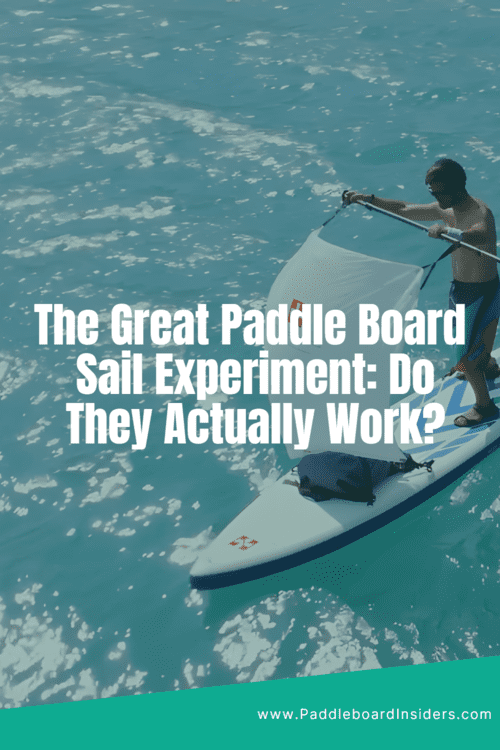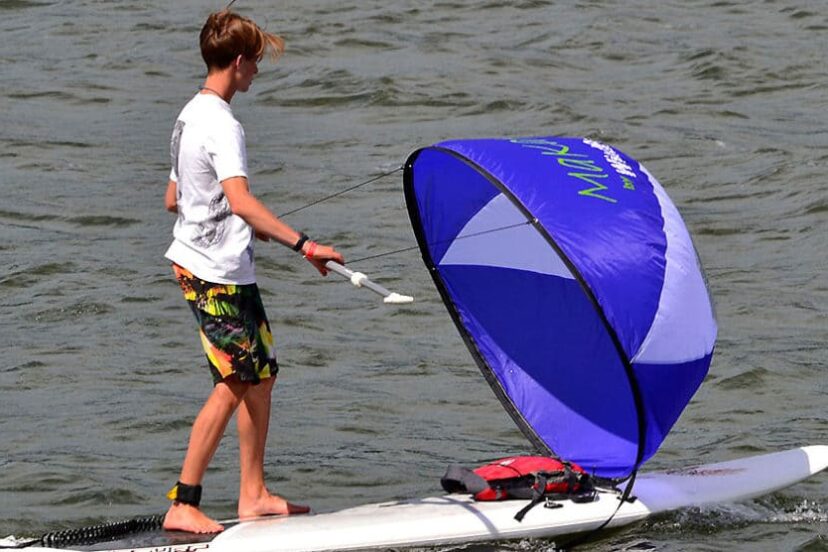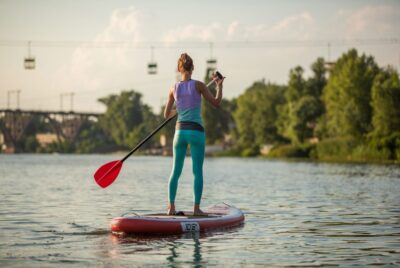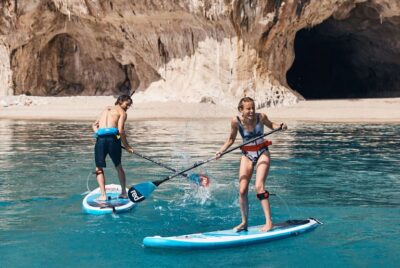The Great Paddle Board Sail Experiment: Do They Actually Work?
*We may earn a commission for purchases made using our links. Please see our disclosure to learn more.
So you might have seen people using a paddle board sail, and maybe you wondered they actually work? Can you legitimately catch the breeze on a stand-up paddleboard?
Paddle board sails are becoming a hot trend, turning quiet paddling sessions into thrilling rides. In this post, we’re diving into how these sails work and whether they’re worth your time, money and effort.
Keep reading to get blown away by what you’ll learn!
| Looking for our best paddle board product recommendations? Check the Paddleboard Insiders Buyer Guides |
Table Of Contents
What Is A Paddle Board Sail?
A paddle board sail is an accessory designed for use with a SUP. It typically consists of a small, lightweight sail that can be attached to the paddle board, allowing the user to harness the power of the wind for propulsion. This sail is meant to add a new dimension to paddle boarding, blending the experiences of sailing and paddle boarding.
he paddle board sail is usually designed to be easy to set up and use, even for those with limited sailing experience. It’s often collapsible or foldable for convenient storage and transport.
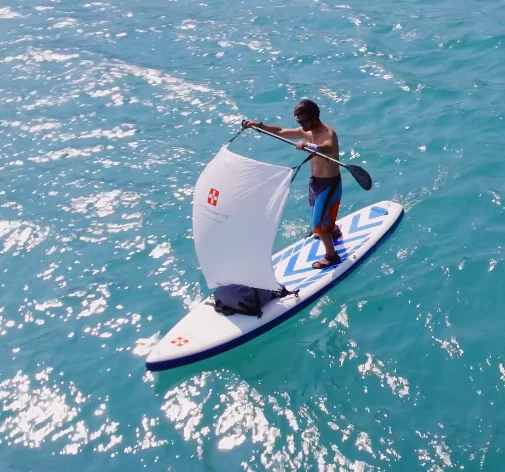
When in use, the sail helps to catch the wind, enabling the paddler to move across the water with less physical effort compared to just paddling. This can be particularly useful on long journeys or in conditions where the wind is favorable.
However, using a paddle board sail requires some skill in wind direction awareness and sail control. It’s an interesting way to enhance the paddle boarding experience, offering a unique blend of paddling and sailing that can be fun for people that love both sports.
This is all theory, but do they actually work?
First let’s talk about how they are supposed to work.
How Do Paddle Board Sails Work?
Paddle board sails work by harnessing wind power to propel the board forward. The sail is attached to the D-rings on your board and positioned based on wind direction, allowing you to navigate and steer your paddle board using sailing techniques.
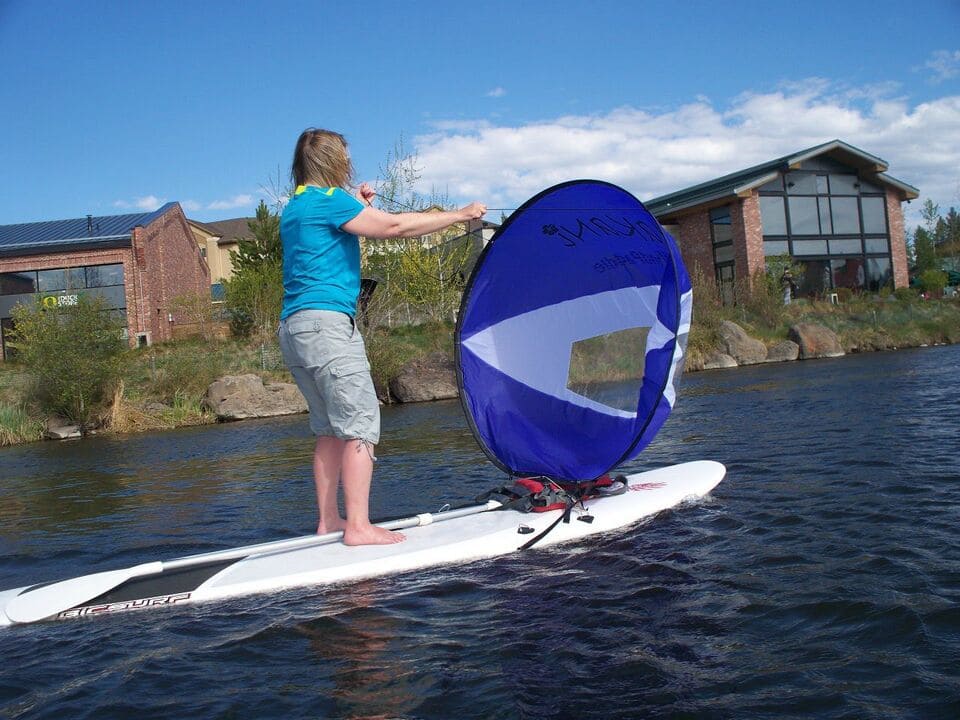
Wind direction and positioning
The direction of the wind is crucial for successful paddle board sailing. Positioning the board to catch the wind and harness its power is essential. By understanding how to angle the sail according to the wind’s direction, paddlers can effectively propel their boards forward.
When catching a favorable wind, positioning your body and adjusting the sail’s angle will allow you to maximize speed and efficiency.
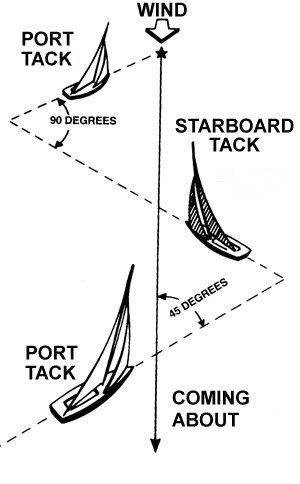
What Was My Experience Like Testing One Out?
So I recently managed to get my hands on a paddle board sail to test it out. I grabbed it off Amazon and got the sail that you see below.
Dyna-Living Paddle Board Sail
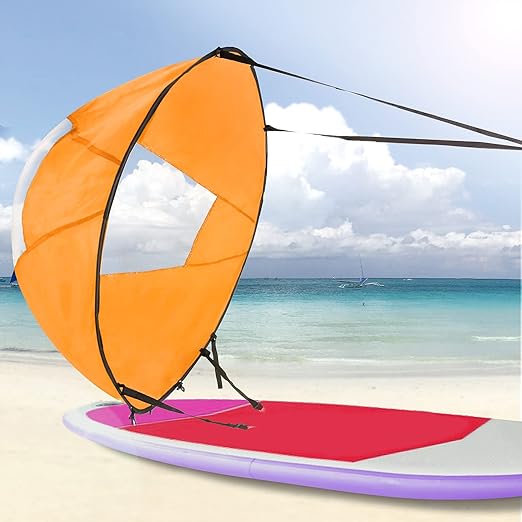
Where To Buy: Amazon
Features & Specs:
– Made of polyester and nylon
– Dimensions of 42.5″L x 42.5″W
– Attaches to the D-rings on your SUP.
| Check Price ➡️ Amazon |
The experience was really interesting, not what I expected at all!
Firstly they 100% do work, but it’s not as easy as you think it might be. You have to make sure that you get the angle right with the wind, I was moving my sail around until it caught the wind and started pulling the SUP.
That took a few minutes of trial and error to figure out, but once I understood how the sail interacts with the wind then it became pretty easy to get moving.
The next challenge was actually heading in the direction that I wanted to go, you have to use the board and create an edge against the water so that you’re tacking against the wind. If you don’t do that then you’re only going to be going downwind.
This is fun, but you have to get back.
It took me a few hours to truly get the hang of it, but once I did then it became something that was really fun to do. I will 100% do this again when it’s windy out.
Here are the pro’s and con’s of these sails based on my experience.
Pro’s & Cons Of A Paddle Board Sailing:
| PROS | CONS |
| – Very interesting and fun to do when the wind conditions are right – You can actually go pretty fast if you’re heading downwind. – The sail is easy to set up, fold up and transport so you can just put it in your bag. – The sail attaches easily to the D-rings on your board. | – Takes some trial and error to get moving – You need to understand how to tack if you’re going to come back upwind (otherwise you’re paddling) – It’s quite tiring on your arms because you’re fighting against the wind. |
| Looking for examples of the best paddle boards in 2024? The 8 Best Inflatable Paddle Boards Of 2024 Reviewed |
How Do You Use A Paddle Board Sail?
Here’s how it looks when moving:
| Check Price ➡️ Amazon |
When it comes to using the sail, it’s quite simple.
- Setting Up the Sail:
- Begin by unfolding or assembling the sail according to the manufacturer’s instructions. Paddle board sails are usually designed to be user-friendly and easy to set up.
- Attach the sail to your paddle board. Most sails come with a universal mounting system that can easily be fixed to different types of paddle boards. Make sure the sail is securely attached.
- Launching:
- After attaching the sail, carry your paddle board to the water. It’s generally easier to launch in a standing position if you are experienced, or from your knees if you are a beginner.
- Once you’re on the water, adjust your position so that you are stable and comfortable.
- Using the Sail:
- To catch the wind, hold the sail’s control rope or handle. This is how you will control the direction and strength of the sail.
- Lean the sail towards or away from you to catch the wind. The angle at which you hold the sail relative to the wind direction will determine your speed and direction.
- Direction Control:
- To steer, you will need to adjust the angle of the sail and use your paddle. You can paddle on one side of the board to help turn it.
- Be aware of the wind direction at all times. You will need to adjust your sail accordingly to maintain control and direction.
- Returning and Disassembly:
- When you’re ready to return, lower or release the sail and paddle back to shore.
- Once ashore, disassemble or fold the sail as per the instructions, and detach it from the board.
Benefits of Using a Paddle Board Sail
| Enhanced Speed and Efficiency: | With the aid of wind power, you can travel faster and cover greater distances on your paddle board. This can be especially beneficial for long-distance touring or exploring. |
| Reduced Physical Strain: | Paddling can be physically demanding, especially over long distances or in choppy conditions. A sail allows you to harness the wind’s power, reducing the amount of paddling needed and thereby lessening physical fatigue. |
| Versatility and Fun | Adding a sail introduces a new dynamic to paddle boarding. It can transform a regular paddling session into a more diverse and enjoyable experience, combining the joys of sailing and paddle boarding. |
| Learning New Skills: | Using a paddle board sail requires and develops skills in wind awareness, sail control, and navigation. It’s a great way to improve your overall watermanship and understanding of wind-powered sports. |
| More Options in Changing Conditions: | With a sail, you can take advantage of windy conditions that might otherwise make paddle boarding challenging or less enjoyable. It can turn a breezy day into an exciting opportunity to try something different. |
| Check Price ➡️ Amazon |
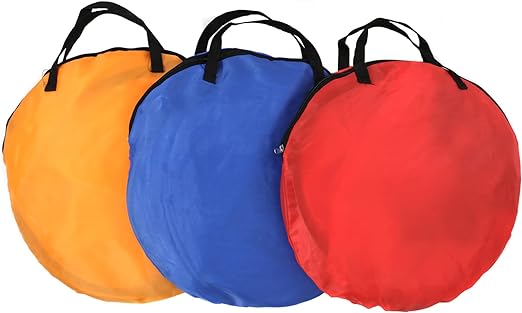
Conclusion
In conclusion, paddle board sails do work effectively. They can enhance your speed and maneuverability on the water while combining the best of paddle boarding and windsurfing. Whether you’re a beginner or seasoned enthusiast, adding a sail to your paddle board opens up new opportunities for aquatic adventure.
So, if you’ve ever wondered about trying out a paddle board sail, the answer is a resounding yes!
Are they actually worth your time and money? Well that depends on you, but I had fun playing around with it.
| Looking for insider guides to some amazing paddle boarding locations? Check the Paddleboard Insiders Location Guides |
FAQs
How does a paddle board sail work?
A paddle board sail works by catching the wind and harnessing its energy to propel the board forward.
Are paddle board sails easy to install?
Yes, paddle board sails are designed for easy installation and can be set up in just a few simple steps.
What type of conditions are suitable for using a paddle board sail?
Paddle board sails work best in moderate wind conditions on calm waters such as lakes, bays, or slow-moving rivers.
Can beginners use a paddle board sail?
Yes, beginners can use a paddle board sail with proper instruction and practice, but it’s important to start in light winds and gradually progress to stronger winds.
Do I need any special skills to use a paddle board sail effectively?
Using a paddle board sail effectively requires basic paddling skills and an understanding of wind direction and safety precautions.
| Check Price ➡️ Amazon |
